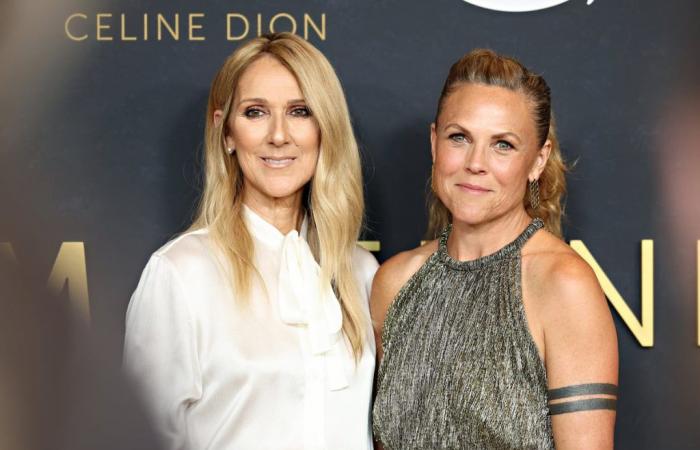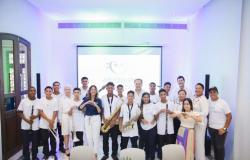
12 minutes of footage are needed for the Céline Dion documentary to begin. The hour and forty of I’m Celine Dionthe film directed by Irene Taylor that can be seen on Prime Video starting June 25, does not start with a very young Dion, with wide eyebrows and curly hair, saying that her dream is to be “an international star and be able to sing all my life” while an aria from Carmen, by Bizet. Nor with her teenage twins, Eddy and Nelson, playing interviewing her and asking her about her favorite color. Not even with the poster that explains that, after releasing 27 albums, of which she has sold 250 million units, and with songs that won the Grammy or the Oscar, the so-called rigid person syndrome forced her to stop and cancel her anticipated tour in 2021. The moment in which the viewer really sits in front of the artist, 56 years old, is when she tells, under dim light, without makeup, with her face swollen due to medication, how one morning, after breakfast, his voice was not his voice. “I was a little scared,” she recalls. The night before everything was going well. That morning everything was going wrong. Nerves and fear arrived. And then, she proves it. Dion opens her mouth, emits a note… and it doesn’t come out. Her voice breaks. As if she were any mortal, not the Canadian who made impossible gurgles with My Heart Will Go On and The Power of Love. It doesn’t come, it can’t. And she starts crying. And the cameras record it.
It turns out incredible. It doesn’t matter how many times she repeats it (many) or the viewer on her screen (maybe even more). It is an immense surprise to see how Dion is unable to sing. That from her highly trained and privileged throat come broken notes that do not even reach the tenth power of what they were. You notice that she hates herself, repeats, cries. Just like she leaves in shock the almost final scene, when for five minutes the interpreter suffers an attack, an immense spasm, which paralyzes her in the middle of recording the documentary and forces her to be treated by doctors. She makes the hair stand on end. But what is most surprising is knowing that it was Dion herself who decided to film the worst moments. Director Irene Taylor (Saint Louis, Missouri, 54 years old) is responsible for this footage and, in an exclusive interview with EL PAÍS, explains that this complete access and those hard scenes were proposed by the artist herself, who had no restrictions on time to show up. “The first day I filmed with her, to be honest, I was impressed. Really impressed by how open she was with me. “She was looking forward to sharing a lot of things with me, things that I didn’t know,” she recalls about the recording, which lasted months.
“During that year I think he decided to make a very conscious decision: ‘I’m going to charge this film with intention. I’m not going to tell Irene what she has to do. I’m going to trust her and let her do her job.’ And that’s how she works with the people in her life,” the director reflects over a video call. “Has managers, assistants, musicians who collaborate and have worked with her for decades. And that tells me a lot about her. She knows how to delegate and make people have their autonomy, and that is very important.” As a chronically ill person and as a global artist, showing herself like this, despite her necklaces belonging to Maria Callas or her mansion in Nevada, represents a conscious decision that exposes her to a universal audience, but also generates recognition. With her real face, her wrinkles, spots, without hair or makeup, in socks in physical therapy sessions, telling how she started with “one pill, two pills, five pills, too many pills” and ended up taking “80, 90 milligrams of Valium per day.” day, and that was just medication.” She is calm when she says that what happens to her is something that happens to “one in a million.” And that she, like so many others with other illnesses, has been touched by it. Which is still a disgrace.
The film, which can be seen in some selected movie theaters since the middle of this week, mainly in the United States, and which arrives on the Amazon platform on Tuesday, lets Dion herself tell her story. There are plenty of people around her—all those musicians, assistants, her children, her butler—but there are no more voices. And that was a request from the artist, Taylor says, in fact, the only one she made of him. “It was before we decided to make the film. She asked me: ‘Is it possible to make a documentary where there are no people talking about me, where I can speak? And if my voice is the only one in the film, is it possible?’ And I told him it was totally possible. In fact, it’s the ideal movie to make for me. ‘But yes: if you want to do it like that, tell me, because you have to prepare yourself, because it will take a lot of time and effort. You’re going to have to spend a lot of time with me,” she recalls with a smile.
It is true that Céline Dion’s documentary could be a compilation of her life and work, almost a panegyric, a testament that could be seen now or in 50 years, talking to her children, showing her warehouse full of haute couture clothing, even receiving medical treatment. But what fills it with strength and uniqueness are the truly personal scenes, where Dion breaks down and is tormented by not being able to control her body: “It makes me tremendously ashamed,” she says, throwing her hands over her head. In which he reveals that his voice has been the rudder that has guided his days, but that he has been suffering from this type of spasms for 17 years, that he avoided them, that he cheated if they appeared in a performance (“I did what my mother told me” ); or that she cannot live without music, but above all without the public: “People give me a lot of energy.”
Are those 100 minutes of footage perhaps the definitive documentary about the most global Canadian artist? Taylor has no answer to this, because he consciously decided to know as little as possible about Dion, and not watch other documentaries about her. “I respect her directors, but, understand me, in my process I did not want to trust the interpretations of others. I wanted to go with a fresh look,” she argues. Her producers looked for material about the artist—old recordings, professional and home, abound in the documentary—and only told her the “basic biographical details, family life, things like that.” “But the truth is that I didn’t want to ask him trick, fake questions, like, ‘I already know the answer to that, but I’m going to ask it anyway,’” she explains. “During the course of the year [del rodaje]when I asked questions, they were real questions, to which I did not know the answer.”
Taylor, on the other hand, accepts every question. The interview is very short, but she is delighted to explain the project, to have people see it, to “have given birth to it,” she laughs. The Amazon team only asks that one question not be asked: about the singer’s health or her future plans regarding her health. Taylor is not Dion, after all. The artist has granted very few interviews (to Vogueto People) and remains calm in her home in Las Vegas. Sometimes she can’t walk or warm up her voice; she spends her time between care, naps and piles of medicine. Training for your next Show, because it is clear that he will return. As she herself says in the documentary: “The difficult thing is not making a show. The difficult thing is to cancel it.”





